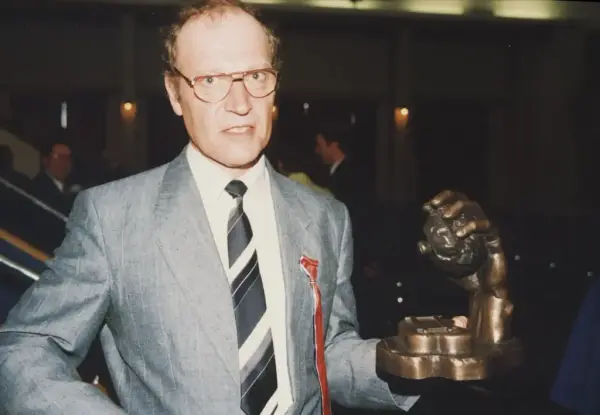In Longyearbyen and Ny Ålesund, the term 'Tyfus' was used to describe what was bad or difficult, a negative term for what one was dissatisfied with and wished was different. It could be a delayed bus, rain, stale beer, poor fish at the workers' mess, lumps in the porridge, or dissatisfaction with other poor food, icy roads, a mine lamp that went out during work, cold water in the shower, or that there were no more fruits in the store. This was common "tyfus". Truly dire conditions were called 'green tyfus'. It couldn't get worse than that. Poor piecework and low profits were part of the "green tyfus". "Green tyfus" was used for the worst tasks, such as mine floor cleaning and coal dust removal. Tyfus with such meaning was associated with the mining environment in Svalbard in the 1950s. Tyfus piecework, tyfus work, tyfus sections, and tyfus geezer were also common terms.
At some point, a kind of surreal iron figure was exhibited in Stormessa in Longyearbyen. The figure was named the Tyfus Figurine. One day, the figure disappeared. Some years later, Gudrun Nerdrum and members of the U.L. Polarleik folk dance group suggested that an award, materialized by a figurine, should be given to a person who had done much to remove or prevent tyfus. Thus, an honor to individuals who stood out positively and had made an extra effort in the local community. U.L. Polarleik awarded the first Tyfus award during the Sun Festival on March 17, 1974. Since then, the prize has been awarded annually, eventually on May 17 instead of during the Sun Festival.
The first two years, the statuette had no specific design but was assembled from various iron parts. In 1976, Arne Trulsvik created the statuette, like we know it today. It took the form of a hand holding a lump of coal. His left hand served as a model. Afterwards, other manufacturers crafted the figurine in wrought iron based on this model. The production was long done by skilled employees at the Mechanical Workshop. In the 1980s, Knut Lindvig forged several of the figurines by hand, using steel. From 1989, it was cast in bronze based on a casting mold made by Lindvig.
- 1/1
Foto: Kjetil Anthonsen/Svalbardposten
In 1996, Tor Grindhaug was awarded the Tyfus award, and thus the Tyfus statuette. Originally from Bø in Vesterålen, Nordland, he completed a 4-year teaching education at Nesna in Nordland (1958-1962) and a 1-year supplementary education at the teacher's college in Volda (1965-1966). For several years, he worked in the school system in Vesterålen and Tysfjord before moving to Longyearbyen in the fall of 1977. Here, he was employed at Longyearbyen School, mostly as a teacher, but at times as a caretaker and educational inspector. In his free time, Tor Grindhaug participated in Svalbard Turn, especially in the ski group, both as a participant and administrator. He was a board member and chairman of the Longyearbyen Hunter and Fishermen's Association, active in the snow mobile and boating association "To-takter'n" and in the Svalbard Council. Tor Grindhaug contributed to various local political forums and union work. When the local Labour Party was revived, he was one of the driving forces. He was awarded the Tyfus award in 1996 for his versatile and active community involvement. The award ceremony took place on May 17th at "Huset".
Tor and his wife Hill (Hillgunn) Grindhaug moved from Longyearbyen back to Bø in Vesterålen in 2002. Tor Grindhaug retired at that time. He passed away in 2007 at the age of 67. In April 2024, the Svalbard Museum received Grindhaug's Tyfus statuette as a gift from his descendants. It is now included in our exhibition. Feel free to stop by and have a look.
